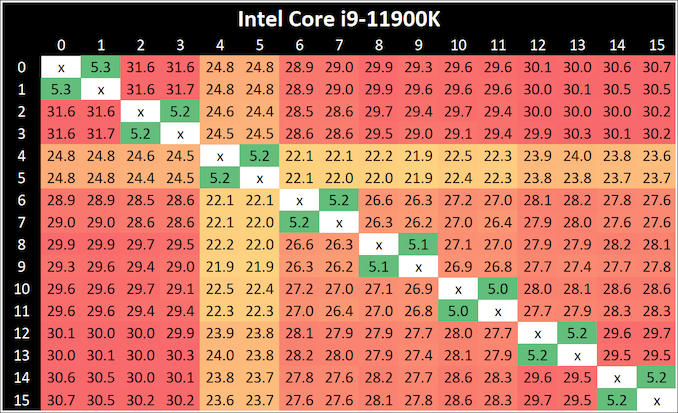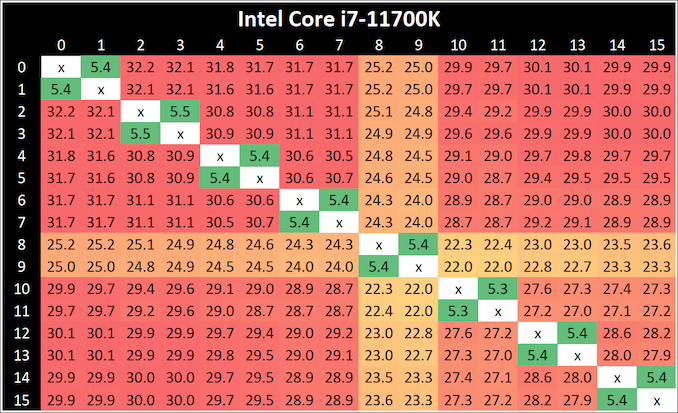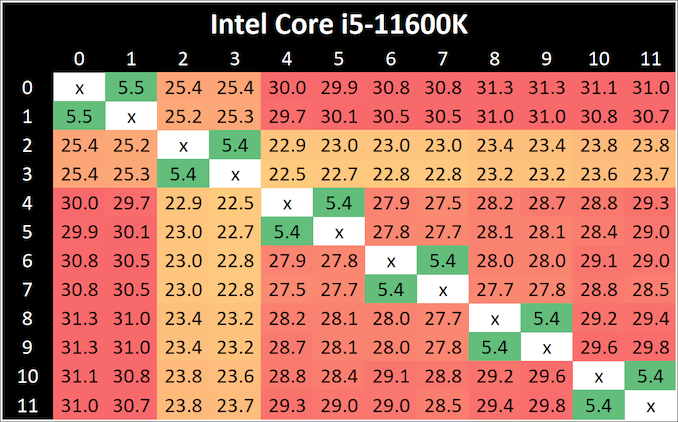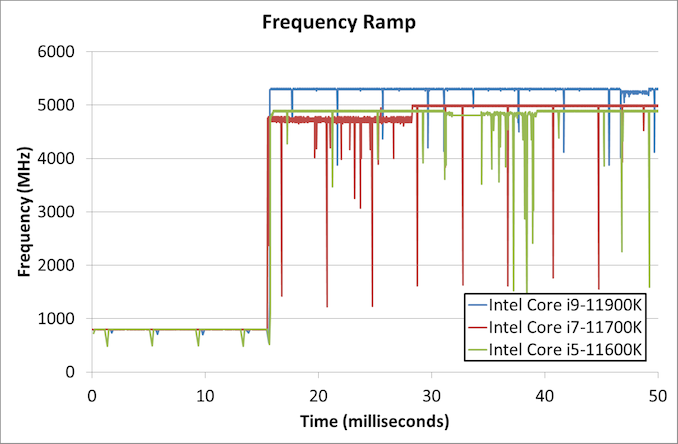Intel Rocket Lake (14nm) Review: Core i9-11900K, Core i7-11700K, and Core i5-11600K
by Dr. Ian Cutress on March 30, 2021 10:03 AM EST- Posted in
- CPUs
- Intel
- LGA1200
- 11th Gen
- Rocket Lake
- Z590
- B560
- Core i9-11900K
CPU Tests: Microbenchmarks
Core-to-Core Latency
As the core count of modern CPUs is growing, we are reaching a time when the time to access each core from a different core is no longer a constant. Even before the advent of heterogeneous SoC designs, processors built on large rings or meshes can have different latencies to access the nearest core compared to the furthest core. This rings true especially in multi-socket server environments.
But modern CPUs, even desktop and consumer CPUs, can have variable access latency to get to another core. For example, in the first generation Threadripper CPUs, we had four chips on the package, each with 8 threads, and each with a different core-to-core latency depending on if it was on-die or off-die. This gets more complex with products like Lakefield, which has two different communication buses depending on which core is talking to which.
If you are a regular reader of AnandTech’s CPU reviews, you will recognize our Core-to-Core latency test. It’s a great way to show exactly how groups of cores are laid out on the silicon. This is a custom in-house test built by Andrei, and we know there are competing tests out there, but we feel ours is the most accurate to how quick an access between two cores can happen.
All three CPUs exhibit the same behaviour - one core seems to be given high priority, while the rest are not.
Frequency Ramping
Both AMD and Intel over the past few years have introduced features to their processors that speed up the time from when a CPU moves from idle into a high powered state. The effect of this means that users can get peak performance quicker, but the biggest knock-on effect for this is with battery life in mobile devices, especially if a system can turbo up quick and turbo down quick, ensuring that it stays in the lowest and most efficient power state for as long as possible.
Intel’s technology is called SpeedShift, although SpeedShift was not enabled until Skylake.
One of the issues though with this technology is that sometimes the adjustments in frequency can be so fast, software cannot detect them. If the frequency is changing on the order of microseconds, but your software is only probing frequency in milliseconds (or seconds), then quick changes will be missed. Not only that, as an observer probing the frequency, you could be affecting the actual turbo performance. When the CPU is changing frequency, it essentially has to pause all compute while it aligns the frequency rate of the whole core.
We wrote an extensive review analysis piece on this, called ‘Reaching for Turbo: Aligning Perception with AMD’s Frequency Metrics’, due to an issue where users were not observing the peak turbo speeds for AMD’s processors.
We got around the issue by making the frequency probing the workload causing the turbo. The software is able to detect frequency adjustments on a microsecond scale, so we can see how well a system can get to those boost frequencies. Our Frequency Ramp tool has already been in use in a number of reviews.
From an idle frequency of 800 MHz, It takes ~16 ms for Intel to boost to the top frequency for both the i9 and the i5. The i7 was most of the way there, but took an addition 10 ms or so.














279 Comments
View All Comments
Oxford Guy - Saturday, April 3, 2021 - link
It’s clearly sarcasm. The Turing stuff, which was a poor value even before this latest mining fiasco is very expensive at its top end — putting it quite outside the budget of a lot of people — that is if they could even get their hands on one in the first place.Qasar - Wednesday, March 31, 2021 - link
maybe you should stop whining and just leave if AT makes you this unhappy, and angry, oxford guyOxford Guy - Thursday, April 1, 2021 - link
When this becomes your personal website then you can decide who is to be censored and who is not. Until then, keep your comments relevant.Qasar - Thursday, April 1, 2021 - link
right after you doOxford Guy - Saturday, April 3, 2021 - link
And look up the tu quoque fallacy.Qasar - Saturday, April 3, 2021 - link
whining and complaining is still the same, no matter how you look at it, again, if this site makes you that unhappy and angry, due to the way they test and review products, then why do you keep coming here ?zamroni - Tuesday, March 30, 2021 - link
it's should be called rocket lame.it runs hot like rocket too
SkyBill40 - Tuesday, March 30, 2021 - link
Tech Jesus said it best and most bluntly: A waste of silicon.SystemsBuilder - Tuesday, March 30, 2021 - link
Ian,your writing about how "hard" AVX-512 is to program was fine in the first article and maybe even in the second article you wrote, but you keep on repeating the exact same sentence (paragraph) on how hard AVX-512 is to program and keep on quoting Jim Keller: "there are only a couple dozen or so people who understand how to extract the best performance ...".
That was a while ago and I can assure you there are plenty of people who know how to do this now. It's assembly and any CS/CE major graduate worth their salt, with linear algebra (vector calculus also helps), advanced computer architecture and a serious parallel programming class would know how to do that with some work.
AVX-512 is not mysterious or strange, it's just vectors math + vectorization of normal scalar operations on configurable 512 bit vectors. Yes you do need to vectorize your algorithms from the ground up because you cannot rely on compilers to vectorize your old sequential scalar algorithms for you (they'll do some attempts, but will disappoint), and you do need to write some code in either assembly directly or using intrinsic, as well as understand pipeline and scheduling of the AVX-512 instructions and the dependencies (there are tools to help you with this too), BUT it's not harder than that. It's not magic. It’s just normal solid Computer Science work. Can you please change the narrative on AVX-512 hardness because I think it is just misleading today 2021, having been available in mainstream CPUs since Skylake-X was released. Thx.
Hifihedgehog - Tuesday, March 30, 2021 - link
Haha. No. Ian is absolutely right and big names in the industry (like Linus Torvalds) are mostly in agreement on this too: AVX-512 hides the the warts of the underlying performance discrepancies of their hardware when doing general everyday compute.